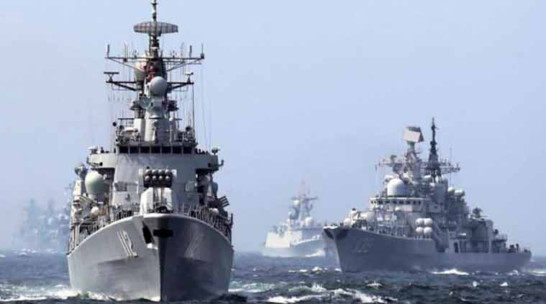
Indian maritime security experts tend to speak of the “maritime blindness” that afflicted India during the 200 year long British colonial rule when the colonial masters suppressed its maritime and seafaring prowess which centuries ago led many enterprising Indians to sail to distant lands in pursuit of commerce, fortune and adventure, leaving behind lasting social and cultural impressions that are still visible in the huge geography stretching from Afghanistan through South Asia to the Far East.
Indian strategists have long recognized that sea power is as important as land and air power. In a globalized world, India’s stake in various maritime regions, particularly in the Indian Ocean, is immense, prompting it to intensify cooperation with the Indian Ocean Rim states.
A combination of security and mercantile compulsions has made India review its naval defense strategy, flanking its land and air forces by strengthening its naval assets. Anticipating challenges in the huge expanse of water across the Indian Ocean – its “backyard”, as some call it - India is building up its naval presence to enhance vigilance and assert its position in the region. China’s aggressive posturing in the Indian Ocean, India’s growing international commerce, and terrorism activities across the sea route, as used by the Pakistan-based perpetrators of the Mumbai terrorist attacks of November 26, 2008, have strengthened India’s resolve to enhance its vigilance on the high sea through a strong naval presence.
India is also participating in joint naval exercises with a number of countries, and held a trilateral exercise called “Malabar” a few months back with the U.S. and Japanese navies.
India also hosted a massive five-day multilateral naval exercise, called the International Fleet Review, (IFR) early February in Vishakhapatnam, drawing some 90 ships and 60 aircraft from several countries, including the USA, China, Britain, Australia, France, Canada, Russia, South Africa, Japan, South Korea, Peru, Chile, Colombia and Brazil.
Indian officials contend that the IFR was aimed to encourage all the participating nations to join hands to fight common security and humanitarian threats at sea; even China, which distrusts – and is distrusted by – some of the IFR participants, participated in the exercise.
While India talks about using navies as a unifying factor – it speaks of “oceans unifying nations divided by disputes” – the IFR’s strategic dimension cannot be overlooked. Apparently, India aspires to play the role of a guarantor of regional security, manifested in the Indian navy’s “new maritime strategy” paper released in October 2015.
India, whose naval assets include a modern home-made ballistic missile nuclear submarine called Arihant and the Vikrant aircraft carrier, is expected to acquire four aircraft carriers as part of its future naval assets.
The Indian navy is creating what some strategists call “smart ships” which, besides performing ocean vigilance and security tasks, can react with alacrity and flexibility to specific security situations. The Indian navy’s recent maneuver at its naval bases in the Andaman and Nicobar islands illustrates the point: deploying its P81 maritime patrol aircraft from these islands, India shadowed a Chinese submarine that had entered Indian waters, forcing it to leave.
India’s fascination for building up a strong blue-water presence is as ancient as its civilization. A recently released book called The Diplomatic Dimensions of Maritime Challenges for India in the 21st Century (Pentagon Press India), intricately woven with historical details, highlights India’s naval aspirations and the reasons behind its strong naval presence in the Indian Ocean.
The book is penned by Yogendra Kumar, a former Indian ambassador to the Philippines – he was conferred the Order of the Philippines called Sikatuna -- with intimate knowledge of the maritime security in the Indian Ocean.
Kumar, a maritime security expert, takes the reader on a journey from India’s past to its future, as the country strives to regain its past glory as a maritime nation and erase the humiliating legacy of “maritime blindness” forced upon it by the British colonial power which described, condescendingly, the Indian Ocean as a “British lake” under the control of a British Royal Navy commander. After attaining independence in 1947, India embarked upon strengthening its naval assets, including the coast guard, the coastal police, shipping and the department responsible for ocean affairs. The Soviet Union’s dissolution prompted India to adapt to the “new normal” in a unipolar U.S.-dominated post-Cold War world, and accelerated India’s naval build-up.
Today’s India is a far cry from its former avatar of an impoverished colony emerging after two centuries of exploitation by the British who exercised unremitting control of their subjects by humiliating them. This wounded pride is also one of the reasons that is vaulting India to increasingly assert itself on the international stage.
Since India’s aspirations also appear to align with U.S. interest to contain Chinese belligerence, particularly in the South China Sea, Washington has been encouraging India to become a net security provider, a role that was mentioned in the U.S. Department of Defense’s report entitled “U.S. Asia Pacific Maritime Security Strategy”.
Whether India will venture beyond its “backyard”, remains to be seen. But the mood in India suggests that it will not shy away from forging closer naval cooperation with equally-keen partners in Asia, including Vietnam, Japan, Singapore and the Philippines.
Indeed, India will further strengthen its naval presence in the Indian Ocean.
End
Manik Mehta is a commentator on Asian affairs.










